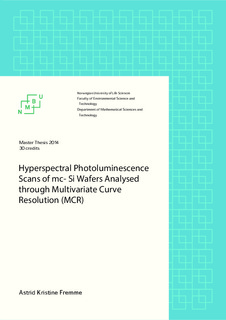Hyperspectral photoluminescence scans of mc- Si wafers analysed through Multivariate Curve Resolution (MCR)
Master thesis
Permanent lenke
http://hdl.handle.net/11250/218116Utgivelsesdato
2014-08-26Metadata
Vis full innførselSamlinger
- Master's theses (RealTek) [1722]
Sammendrag
Characterisation of defects in solar cell material is one step towards higher energy conversion efficiency of solar cells. The method used in this study allows detection across the wafer of defects causing radiative SRH recombination.
In this experiment 30 unpassivated, full size mc-Si wafers from three different ingots are cooled to 90K. Emissions after excitation with a 808 nm laser are detected by scanning the samples with a hyperspectral camera recording in the range 900-2500 nm, which includes both band-to-band photoluminescence (BB-PL) and defect related luminescence (DRL).
Multivariate Curve Resolution (MCR) statistical analysis is used to separate the recorded emission into different signals. Even though surface recombination greatly influences the results, eight different signals were found for the most signal-rich wafers from one ingot (B2). Although all samples from one ingot are believed to contain the same types of defects, emissions were only separated into a few signals for the most defect-rich samples. Wafers from the B2 ingot are standard mc-Si wafers, with both grain size and number of emission signals successfully differentiated increasing with increasing height on the ingot. The wafers from the two other ingots are HPM Si wafers, and are more stable in respect to both grain size and number of signals differentiated from wafers from different heights on the ingot. Emission signals were identified as being of specific energy, but they were not always distinctively coupled with emission signals from literature.
